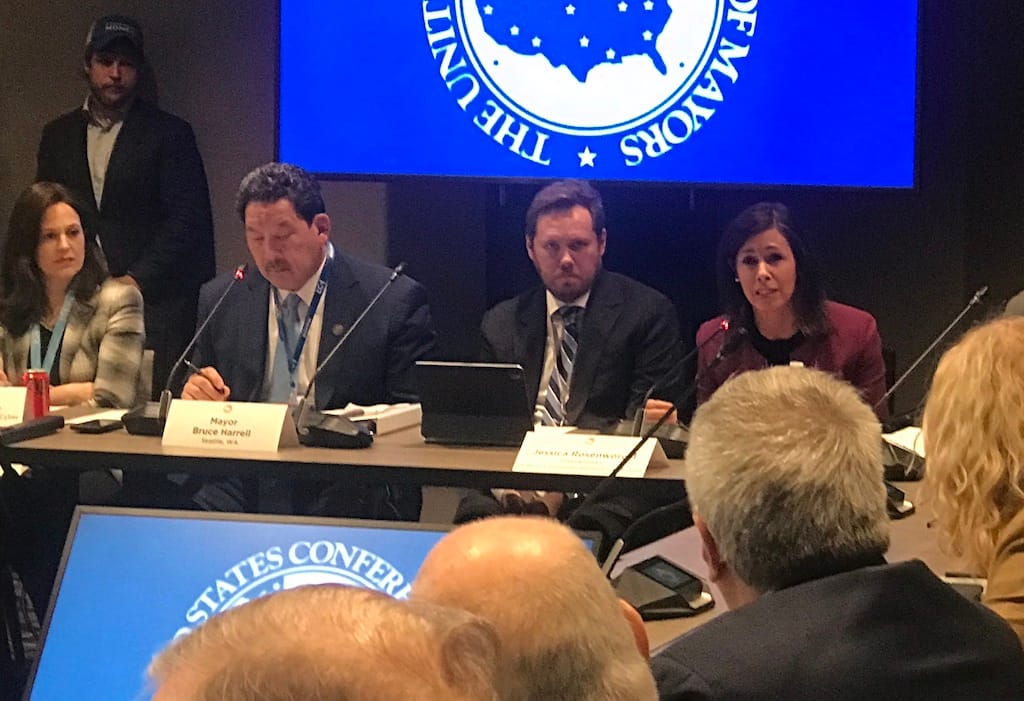Subsidies for Hotspot Devices a ‘Great Idea,’ FCC Chairwoman Says
The commission has been exploring the broadening of the E-Rate program, a high-cost program under the Universal Service Fund.
Ahmad Hathout

WASHINGTON, January 18, 2023 — Federal Communications Commission Chairwoman Jessica Rosenworcel said Wednesday at the Conference of Mayors that an agency program subsidizing mobile hotspot devices is a “great idea” and that there may be some activity on that front in the future.
The chairwoman was fielding a comment from a mayor of a Texas city, who said that his jurisdiction has a program that lends out connectivity hubs – allowing others to connect to the device – in parts of the town for residents seeking internet. He asked whether that’s something that the FCC could fund.
“That’s a great idea,” said Rosenworcel to a packed breakout room including mayors from cities across the country.
Rosenworcel noted that the commission has been exploring the broadening of the E-Rate program, a high-cost program under the Universal Service Fund that subsidizes library and school broadband connectivity.
She said the commission may be able to expand the program to encompass funding for hotspot devices.
“Stay tuned,” she added, “because I think you’re onto something.”
Groups have, in the past, urged the E-Rate program to go beyond the schools and libraries and to households. An existing program, called the Emergency Connectivity Fund, helps students get connectivity outside of school.
Affordable Connectivity Program needs mayoral outreach
The chairwoman also touched on the need for mayors to help get the word out on the Affordable Connectivity Program, a $14.2 billion initiative that provides a broadband subsidy of up-to $30 per month to low-income families and up-to $75 for households on tribal lands.
The FCC said roughly 16 million Americans are on the program, but it suspects there are many more households that are eligible. That’s why it has set up four outreach programs to get the word out.
When asked about the longevity of the ACP, the chairwoman said there is still a lot of money leftover – some estimate over $10 billion – indicating a need to get the word out to fill the gaps.
But she noted that if it comes to it, the agency may need to go back to Congress and ask for its long-term survival because it’s “too important to stop.”
Open RAN technologies encouraged for BEAD funding
The small conference also included a cybersecurity official from the White House, who provided an overview of strategies for cities to protect themselves from attacks.
Anne Neuberger, a White House advisor for cybersecurity, said one recommendation for cities applying for federal broadband funding – specifically from the National Telecommunications and Information Administration’s Broadband Equity, Access and Deployment program – is to use that money toward open radio access network technologies.
Open RAN is a mobile wireless protocol that allows for the interoperability of devices, allowing telecommunications companies to forgo relying on proprietary technologies from companies deemed a threat to national security, such as Huawei and ZTE.
The NTIA is currently fielding comments on how it should craft a $1.5 billion program spawned by the Chips and Science Act that seeks to explore alternatives to wireless equipment.
Last month, the United States, United Kingdom, Australia, and Canada signed onto a commitment to “ensuring the security and resilience of our telecommunications networks, including by fostering a diverse supply chain and influencing the development of future telecommunications technologies such as 6G.
“Collectively, we recognize that open and interoperable architectures are one way of creating a more open, diverse and innovative market,” a collective statement said.










Member discussion